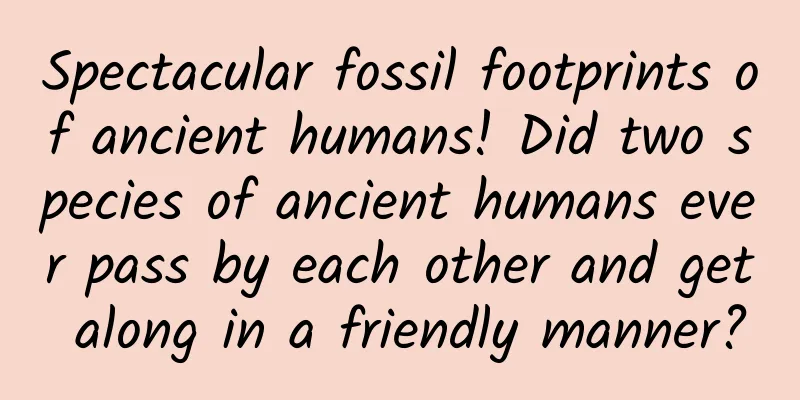Spectacular fossil footprints of ancient humans! Did two species of ancient humans ever pass by each other and get along in a friendly manner?

|
Produced by: Science Popularization China Author: Niu Changtai (PhD, Nanjing Institute of Geology and Paleontology, Chinese Academy of Sciences) Producer: China Science Expo Editor's note: In order to understand the latest developments in cutting-edge science and technology, the China Science Popularization Frontier Science Project has launched a series of articles titled "Understanding Top Science Journals", which selects outstanding papers from authoritative journals and interprets them in plain language as soon as possible. Let us broaden our scientific horizons and enjoy the fun of science through the window of top journals. Elves, dwarves, goblins, orcs, humans... In Western fantasy literature, different humanoid species can live in the same world at the same time, conquering and plundering each other, or coexisting in cooperation. Back to reality, looking at the earth today, there is only one human species, that is, us - modern humans. As the only intelligent life on this planet, have you ever thought that our ancestors were as lonely as we are today? Are they the only masters of this planet? The answer to the above question is no. Evidence from molecular anthropology, archaeology, and paleoanthropology all indicate that modern humans have only been the only human species on Earth for 30,000 to 40,000 years. For millions of years before that, our ancestors coexisted with other ancient humans. For example, Denisovans and Neanderthals had genetic exchanges with our ancestors, and the genomes of modern humans retain their genetic traces. Archaeological and chronological studies of ancient human fossils have also proved that different ancient human species in the same area can overlap in time distribution, and it is speculated that they may have met each other. But all this evidence is only indirect evidence. For a long time, humans have never found evidence that the fossils of multiple ancient humans are directly preserved together. Until recently, a study published in the journal Science completely changed this situation. Comparison of skulls of modern humans (left) and Neanderthals (right). Genetic exchange occurred between the two in the past. (Image source: Wikipedia) On November 28, 2024, an international research team composed of researchers from the United States, Germany, the United Kingdom and Kenya published a research article in the journal Science on 1.52 million-year-old human footprint fossils on the east coast of Lake Turkana in Kenya. The study showed that these human footprint fossils belonged to two human species, Homo erectus and Paranthropus boisei. These footprint fossils were formed within a few hours to a few days, directly proving that these two ancient humans coexisted in the same time and space. This is the first time that humans have found evidence of the coexistence of two ancient humans. Related research results were published in Science magazine (Image source: Webpage screenshot) A treasure trove of human fossils: the amazing Turkana From the origin of humans to the origin of the genus Homo and then to the origin of modern humans, Africa can find fossil records corresponding to each stage of human evolution. Among the many human fossil production sites in Africa, most of them are distributed on both sides of the East African Rift Valley. The unique natural geographical environment of the rift valley not only created a home for ancient humans to survive, but its densely distributed lakes and water systems also created a unique burial environment, allowing many ancient humans to rest here to form fossils, waiting to see the light of day again in the excavation of "descendants" millions of years later. The forest and savanna landscape of the East African Rift Valley has been the cradle of human evolution for millions of years. (Image source: Wikipedia/genvessel) **Among the many human fossil sites in the East African Rift Valley, the Turkana Basin is a gem among gems. **The basin has produced as many as seven ancient human species, dating back to 4.2 million years ago, including Australopithecus anamensis, Kenyan flat-faced man, Paranthropus ethiopianus, Paranthropus boisei, Homo habilis, Homo rudolfensis and Homo erectus. Among them, Australopithecus anamensis, Paranthropus ethiopianus and Paranthropus boisei, although they are humans, do not belong to the genus Homo and are more distantly related to us. Judging from their facial features, their mouths protrude more forward and their teeth are larger, making them more similar to apes. Homo habilis, Homo rudolfensis, and Homo erectus belong to the same genus as us, Homo. They are more closely related to modern humans, and there are even fossils representing our ancestors who roamed Africa between 2 million and 1 million years ago. Lake Turkana is located in the center of the Turkana Basin. The flag in the picture indicates the location where the fossil was discovered. (Image source: modified from Wikipedia/Rudyologist) The Koobi Fora site on the east coast of the Turkana Basin contains a very rich collection of human fossils, representing up to 230 individuals from four human species - Paranthropus boisei, Homo habilis, Homo rudolfensis and Homo erectus - ranging in age from 2.1 million to 1.4 million years ago. What’s even more amazing is that this area also contains a large number of human footprint fossils, which means that we can not only understand what ancient humans looked like based on the fossils, but also understand how they moved based on these footprint fossils. Time distribution of human fossils (Image source: modified from The Natural History Museum, London) Passing by: A snapshot in time 1.52 million years ago In July 2021, a very spectacular trace fossil layer was discovered at the Kubi-Fola site, which densely preserved 15 human footprints, 61 bird footprints, 30 bovine footprints and 3 horse footprints. Such a dense density of footprint fossils indicates that this area may represent a place where various animals drank water and foraged for food. Based on the layers of trace fossils preserved and the sediments above and below, the researchers speculated that these footprints were formed in water several centimeters deep around Lake Turkana. After the footprints were formed, they were never exposed to the air but were always covered by water. Within a few hours to a few days, they were quickly buried by sediments brought by upstream rivers, thus being preserved. This means that the footprints preserved on the same layer were also formed within a few hours to a few days. Compared with the time scale of tens of thousands of years in paleoanthropology, footprint fossils formed within a few days and preserved on the same layer are precious snapshots of human evolution over millions of years. Excavation site of footprint fossils (Photo credit: Kevin Hatala/Chatham University) Among the many footprint fossils, paleoanthropologists are most concerned about human footprints. Among the 15 human footprint fossils, 12 footprints are distributed on the same path, which were formed by a human individual walking quickly from south to north at a speed of about 1.81 meters per second. The remaining 3 footprints are isolated footprints with different directions and positions, and are believed to be formed by three individuals. The researchers used dual-plane X-ray photography to computer model the three-dimensional morphology of each footprint, and used software to measure the footprint model to obtain two important data sets, the relative arch volume and the abduction angle of the big toe. At the same time, the researchers also compared these measurements with 340 modern human footprints, modern human footprints found in the Holocene in Walvis Bay, Namibia, ancient human footprints in Laetoli, Tanzania, 3.66 million years ago, and other ancient human footprints around the Turkana Basin from 1.4 million to 1.6 million years ago. A partial 3D reconstruction of the footprint fossil. There are also a large number of bird footprints on the surface, most of which may have been made by Leptoptilos falconeri. (Photo credit: Kevin Hatala/Chatham University) The study found that two of the three separate footprints had similar relative arch volumes to modern human footprints. Recall that when we walk, we step out with one foot and, when we are about to land, we first touch the ground with the heel (heel), then the entire sole of the foot, then lift the heel, support with the forefoot and toes, and take the next step with the other leg. When the heel or forefoot supports the body, the contact area is smaller, the pressure is greater, and the depth of the footprint left is also deeper. When the entire sole of the foot touches the ground, the contact area is larger and the pressure is smaller, so the depth of the footprint is also smaller. Therefore, the footprints left by modern humans are deep in the front and back and shallow in the middle , which makes the bulge at the arch of the footprint fossil very obvious, which is reflected in the larger relative arch volume in measurement. The owners of these two footprints with similar relative arch volumes to modern human footprints may have similar foot movement patterns as modern humans, namely the heel-plantar-toe flip mode. Fossilized footprints similar to modern human footprints (Photo credit: Kevin Hatala/Chatham University) The measurement of 12 consecutive footprints from the same individual revealed that their relative arch volumes were much smaller than those of modern humans, which is reflected in the fact that the footprint fossils are generally flatter and the bulge at the arch position is not that obvious. This shows that the movement patterns of the owners of these footprints are significantly different from those of modern humans and the owners of the other two isolated footprint fossils. Footprints that form a continuous track, footprint fossils that are quite different from modern human footprints (Photo credit: Kevin Hatala/Chatham University) Regarding the study of the big toe abduction angle, the researchers found that the big toe abduction angle of 12 consecutive footprints was, as a whole, significantly higher than the maximum big toe abduction angle of modern human footprints by about 10°, and could reach a maximum of nearly 30°. At the same time, the position of their big toes is not so fixed when walking. The data shows that the difference between the maximum and minimum values of the big toe abduction angles of multiple footprints formed by the same foot (left or right foot) is greater than the 10.6° maximum of modern human footprints, 15.9° for the left foot and 19.1° for the right foot. This also means that the foot morphology of ancient humans who formed continuous footprints is significantly different from that of modern humans, that is, the big toe is more flexible, has a larger space for movement, and can be separated further from other toes. At this point, we can see that these 15 footprints clearly represent two types of individuals. The owners of the two isolated footprints walked in a very similar way to modern humans, leaving footprints of similar shape. The owner of the continuous footprints walked in a way and had foot shapes that were significantly different from those of modern humans, and the footprint shapes were also very different. After comparing the morphology of the continuous footprints with those of ancient humans in other regions, the researchers found that they were more similar to 3.66 million-year-old ancient human footprints discovered in Laetoli, Tanzania, which are believed to have been made by Australopithecus. Australopithecus is a more primitive species. Unlike Homo erectus, they are more adapted to arboreal life, and their bipedal movement on the ground is significantly different from that of Homo erectus. Homo erectus almost completely gave up living in trees, and their long-term life on the ground made their bipedal walking more efficient, with foot morphology and movement closer to modern humans. A replica of a fossilized human footprint from Laetoli, Tanzania. The footprints are currently thought to have been made by Australopithecus. (Image source: Wikipedia/Momotarou2012) At this point, the last question left in front of the researchers, and the most critical one, is who are the owners of these two completely different footprints? The easiest way is to check which ancient humans lived in this area when these footprint fossils were formed. Based on the chronological study of the volcanic tuff 10 meters above the footprint fossil layer, the researchers inferred that the footprint fossil layer was formed about 1.52 million years ago. Among the four ancient humans produced at the Kubi Fora site, the fossil records of Homo rudolfensis and Homo habilis are older than 1.7 million years ago, after which they disappeared, while the fossil records of Homo erectus and Homo erectus can last until nearly 1.4 million years ago, indicating that at this point in time 1.52 million years ago, the ancient humans who left these two completely different footprints were most likely Homo erectus and Homo erectus! Coexisting in harmony: two ancient human survival strategies Although past fossil chronology studies have shown that the distribution of Paranthropus and Homo erectus in the Koubi-Fula region overlapped in time, the time difference between fossils produced in different layers and locations can be thousands or even tens of thousands of years, and we cannot prove that the two ancient humans may have seen each other. The newly discovered footprint fossils, however, limit the time that the two appeared in the same place to a few days or even hours. Considering the spatial compactness (within a few meters) and temporal instantaneity (within a few days) of the footprint fossils, if we zoom in on a larger spatial and temporal scale, the probability that the two had intersected is almost 100%. Reconstruction of a Homo erectus boy from the west shore of Lake Turkana, 1.6-1.5 million years ago (Image source: Wikipedia/Neanderthal Museum) In fact, researchers have also studied human footprint fossils dating back 1.6 million to 1.4 million years ago in many places in Koubi Fora, and found that these footprints are clearly divided into two categories, one similar to modern humans, and the other similar to the newly discovered continuous footprints. This means that from the perspective of footprint fossils, Paranthropus bovis and Homo erectus coexisted in today's Koubi Fora for 200,000 years between 1.6 million and 1.4 million years ago. How did these two ancient humans get along during such a long period of time? Reconstruction of the face of Paranthropus baumannii (Image source: Wikipedia/Cicero Moraes) The earliest fossils of the genus Homo were found about 2.8 million years ago. Homo erectus belongs to the genus Homo, and Homo bois belongs to the genus Paranthropus, which means that the ancestors of the two species had already diverged before 2.8 million years ago, which is nearly 1.3 million years more than 1.52 million years ago. During this long period of time, the lifestyles of the two species had already diverged. Earlier studies have suggested that Paranthropus had strong jaws and thick teeth, which were suitable for eating hard foods that are not easy to chew, such as seeds and nuts. However, in 2011, the analysis of carbon isotopes in the teeth of Paranthropus showed that Paranthropus may have mainly fed on C4 plants, that is, various grass plants commonly found on African grasslands and the edges of rivers and lakes, such as sedges and reeds. These plants have low nutritional value and contain siliceous minerals that wear down teeth, so Paranthropus' teeth have thicker enamel to resist such wear. The facial reconstruction of Paranthropus boisei shows that its skull is very different from that of modern humans, with a larger jaw, thicker teeth, and a sagittal ridge on the top of the skull. (Image source: Wikipedia/Cicero Moraes) Homo erectus, the genus of humans, became skilled in using various tools during their long evolution. They would hunt or scavenge for meat from the remains of carnivores such as lions and leopards. They would also use stone tools to crack open bones and suck out the marrow. It can be said that animal foods rich in protein and fat occupy an important position in the diet of Homo erectus, and these nutritious foods also promote their brain development. At the same time, they also ate plant foods such as fruits, seeds, and tuberous roots, and they may have used tools to preliminarily process the food, making it easier to chew. Therefore, the jaws and teeth of Homo sapiens, which are adapted to "fine processing" food, are smaller than those of Paranthropus, which eats rougher and tougher foods. The face is also flatter. Facial reconstruction of Homo erectus - Turkana boy. Its skull morphology is similar to that of modern humans, with a flatter face and no sagittal ridges, but it is overall more robust. (Image source: Wikipedia/Cicero Moraes) At the same time, between 1.6 million and 1.4 million years ago, the Kubi-Fura region where Homo erectus and Paranthropus lived was located on the edge of Lake Turkana, where rivers were well developed. Such an environment could provide diverse habitats, including relatively humid wooded forests and relatively dry open shrub forests and grasslands. Paranthropus and Homo erectus could move around in different areas according to their feeding preferences, and occasionally come to the lake to drink water and greet each other when they were thirsty. They did not interfere with each other, did not compete, and lived in harmony. Unfortunately, as the environment changed, Paranthropus became extinct after a few hundred thousand years, while Homo erectus was more adept at using tools, had a more diverse diet, and was better able to adapt to changing environments. Homo erectus may have existed in Africa until 600,000 years ago, after which they also became extinct. But the various more advanced members of the genus Homo in Eurasia and Africa, including Homo antecessors, Homo heidelbergensis, Neanderthals, Denisovans, and modern humans, may all be related to Homo erectus in Africa as far back as a million years ago. So, in a sense, Homo erectus did not die out, but rather evolved into the many different species of humans, including us. Conclusion 1.52 million years have passed, and the footprint fossils on the shore of Lake Turkana have frozen the lively scene at that time, telling the prosperity of the past. Today, the local biological appearance is slightly different from that of that time. Homo erectus, Paranthropus boweni and the adjutant stork that formed the large bird footprints are no longer in existence, while their living relatives - modern humans and African adjutant storks are still active in the area. How did these ancient humans interact with each other? What was their relationship with the other animals around them? Fossilized footprints can prove the coexistence between different humans and between humans and animals, but they cannot show the relationship between these animals. I hope that there will be more discoveries in the future that can show the stories between these creatures more completely and clearly. References: [1] Kevin G. Hatala et al. ,Footprint evidence for locomotor diversity and shared habitats among early Pleistocene hominins.Science386,1004-1010(2024).DOI:10.1126/science.ado5275 |
<<: "Half lake, half fire", here hides the most beautiful winter in China
Recommend
Lu Zhanka - Short video live marketing secrets, maximize traffic and monetization
Course Catalog├──01. The creative formula behind a...
Will television really die under the influence of mobile Internet?
In this era of rapid development of mobile Intern...
Practical information | A comprehensive review of Toutiao products and strategy optimization
In recent years, Toutiao has developed rapidly, a...
APP promotion: mainstream customer acquisition channels and methods
With the development of App development technolog...
How can brands operate Bilibili well?
Enterprise accounts are an important platform for...
Beware! Two more cases of Omicron infection detected in China! The latest assessment by the National Health Commission...
From 0:00 to 24:00 on December 18, 83 new confirm...
Cook's attack is Apple's retreat
[[136306]] WWDC 2015 is Apple's annual colleg...
Source code advanced analysis of the lifecycle component principle
[[421728]] Preface How to use the classes provide...
Practical self-media toolkit (software + tutorial + material + subtitles) collection
With the continuous popularization of China's...
From BAT mini programs to mobile phone manufacturers' quick apps: they look similar, but each has its own pain points
[[237510]] Image source: Visual China According t...
Deng Jiaxian: The pioneer of China's nuclear weapons development | The childhood of the "two bombs and one satellite" hero
Deng Jiaxian, one of the founders and pioneers of...
Science Museum丨Why can we hear mosquitoes buzzing when the lights are turned off, but can’t hear them when the lights are turned on?
Summer is coming, and as the temperature rises, m...
B station nanny-level delivery tutorial
When a brand is starting up, it often struggles w...
Graduated from a vocational high school and started from a junior college, why is he one of the top 2% of scientists in the world?
On September 16, 2024, Stanford University in the...
![Kingdee Software: Efficient Office [WeChat Enterprise Account Case]](/upload/images/67ebf29243d57.webp)








